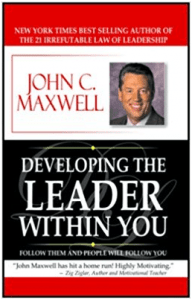AUTHOR: JOHN C. MAXWELL

ABOUT THE AUTHOR:
John C. Maxwell is an internationally recognized leadership expert, speaker, coach, and author who has sold over 19 million books. Dr. Maxwell is the founder of EQUIP and the John Maxwell Company, organizations that have trained more than 5 million leaders worldwide. Every year he speaks to Fortune 500 companies, international government leaders and organizations as diverse as the United States Military Academy at West Point, the National Football League, and the United Nations. A New York Times, Wall Street Journal, and Business Week best-selling author, Maxwell has written three books which have each sold more than one million copies: The 21 Irrefutable Laws of Leadership, Developing the Leader within You, 101 Relationship, 101 Leadership and The 21 Indispensable Qualities of a leader. Developing the Leader within You is Dr. Maxwell’s first and most enduring leadership book, having sold more than one million copies. In this Christian Leaders Series edition of this Maxwell classic, you will discover the biblical foundation for leadership that John Maxwell has used as a pastor and business leader for more than forty years. These same principles and practices are available for everyday leaders in every walk of life.
BOOK SUMMARY:
No matter how good you are at your work, how ambitious your goals are, and how much energy and stamina you have, if you’re not a leader, none of it guarantees your success, since, “The effectiveness of your work will never rise above your ability to lead and influence others.”
A group of people was strolling through a village. When they passed an old man, one of them asked condescendingly, “Were any great men born in this village?” “Nope,” the old man answered, “Only babies.” The moral of the story: Although some people seem to be “born leaders,” most need to learn leadership from experienced role models.
“Leadership skills determine the level of your success- and the success of those around you.”
You can use the following 10 principles to become a mature leader:
Principle One: “The Definition of Leadership: Influence”
Leaders need followers, whom they attract because of their influence. Everyone has influence with at least a few people. In fact, everyone is a leader at some times and a follower at others. The difference between the average person and the leader is scope.
“People don’t care how much you know until they know how much you care. Leadership begins with the heart, not the head.”
Leadership has five successive components; each one depends upon the one that precedes it.
- “Position: People follow because they have to”– A title gives you authority, but not necessarily influence. Bosses are not automatically leaders. Instead, your influence grows according to the intensity of your commitment.
- “Permission: People follow because they want to”– Your followers must also make a commitment; you need their permission to lead. To gain and keep it, you must build solid relationships with them.
- “Production: People follow because of what you have done for the organization”– Once you’ve built relationships, you and your followers achieve results together.
- “People development: People follow because of what you have done for them”– Good leaders are mentors. People follow them because somehow, when they do so, they feel inspired to perform better than usual.
- “Personhood: People follow because of who you are”– After a lifetime of leadership, you develop personal charisma; people follow you because of the values you embody.
“Integrity is not a given in everyone’s life. It is a result of self-discipline, inner trust and a decision to be relentlessly honest in all situations.”
Principle Two: “The Key to Leadership: Priorities”
Setting priorities separates successful pros from dilettantes. The “20/80 rule,” or “Pareto Principle,” which says that 20% of your activity yields 80% of your results, comes in handy for managing priorities. Identify your top priorities and put most of your energy into them.
Examine your priorities to create an efficient strategy for success, which is the steady progress toward a goal. Often, you can delegate or even neglect routine activities to give yourself more time for your most important work. To sort your priorities, determine what is absolutely required of you, which areas you enjoy the most and which activities yield the greatest returns. Re-evaluate your priorities regularly, since situations change.
“There is nothing more difficult to undertake, more perilous to conduct or more uncertain in its success than introducing change.”
Principle Three: “The Most Important Ingredient of Leadership: Integrity”
The definition of integrity is simple: say what you mean and do what you say. Putting this into practice, of course, is difficult. Spend time clarifying your deepest convictions for yourself and make them your guidelines for action. Earn others’ trust by setting a consistent, personal example. No one has confidence in a phony or a hypocrite. Take responsibility for your decisions and behavior. As you gain power, you will need to become more accountable – which is why integrity is so important for leaders. Seek out your loyal opposition and take criticisms to heart.
Principle Four: “The Ultimate Test of Leadership: Creating Positive Change”
Leaders, like all human beings and even all organizations, resist change. Their character, activities, goals and strategies give them a certain momentum, and redirecting it is like turning an ocean liner. Persuading others to change is even harder. Those who flourished under the old system quite rationally resist changing it. Others are simply set in their ways, and change brings up fears and disrupts their comfortable patterns. Yet the only constant in life is change. If you aren’t growing and changing, you aren’t leading.
“Every new idea goes through three phases: It will not work; it will cost too much; and, I thought it was a good idea all along.”
To facilitate change, examine your organization’s needs, both technical and motivational. Providing inspiration is key. Before you ask others to change, demonstrate your own willingness to change. Ask others to participate and to share their ideas. They’ll be more likely to support a process they feel they own. Keep the lines of communication open and explain the advantages of the change to all of your stakeholders. Provide psychological support by giving everyone time to think about and assimilate change. If you present the shift as an augmentation or refinement of previous routines, rather than as a total revolution, you’ll encounter less resistance.
For example, to guide your staff through an innovation, discuss change in meetings that follow these steps:
“Failure only truly becomes failure when we do not learn from it.”
- Discuss “information items”– Highlight successes.
- Introduce “study items”– Propose new ideas, but don’t rush to a decision.
- Vote on “action items”– These evolve from the study items.
Principle Five: “The Quickest Way to Gain Leadership: Problem Solving”
Every firm has problems. Think of them as gifts because they can teach you valuable lessons. Seek them out. A positive attitude will help you fix problems, but poor attitudes short-circuit solutions more often than the intractability of the problems themselves.
“Our focus as a leader should be to build big people. Big people will handle big issues effectively.”
Follow these problem-solving guidelines:
- Organize problems in order of priority and deal with them one at a time.
- Learn all you can about the situation. List all the possible causes of the problem.
- Examine the problem within the context of current trends and organizational goals.
- Define the issue. Use just one sentence if possible.
- Discuss the problem with trustworthy, creative colleagues.
- Look beyond your assumptions. Come up with as many potential solutions as you can.
- List the possible solutions, starting with those you think are most likely to succeed.
- Ask others to find the operational weaknesses in your solutions, but ignore mere opinion.
- Evaluate your resources.
- Make decisions.
“For your leadership to remain effective, it is essential that you take the other influencers within the group with you to the higher levels.”
Although problems may be gifts, you should still implement procedures and policies to prevent them. For example, encourage staff people to think the best of each other, especially during disputes. Bring others into your process by asking them to solve problems with you – otherwise, you’ll end up having to solve all your organization’s problems yourself.
Principle Six: “The Extra Plus in Leadership: Attitude”
You may have no control over some things that happen in your life, but you can control your response to them. That’s attitude. When you’re a leader, your attitude influences everyone around you, so nurture a positive approach. Optimism won’t appear automatically or run perpetually. Work every day to replace negative thinking with positive expectations. If you begin to suffer “psychosclerosis,” or a “hardening of your attitude,” the time has come to do some “change work”. Importantly you shouldn’t wait to take action until you feel motivated or inspired. Chances are that if you “just do it,” motivation will follow.
“The one who influences others to follow only is a leader with certain limitations. The one who influences others to lead others is a leader without limitations.”
Try the following:
- Become aware of feelings that could cause a problem.
- Figure out the source of those feelings.
- Identify the places where your thinking trips you.
- Replace poor attitudes with positive ones.
- Declare your intention to think positively.
- Make a plan, such as asking a friend for support or associating with positive people.
“I have yet to find a person who did not do better work and put forth greater effort under a spirit of approval than under a spirit of criticism. Encouragement is oxygen to the soul.”
Principle Seven: “Developing Your Most Appreciable Asset: People”
Good leaders inspire others to become leaders. They bring out the best in the people around them. Everyone needs encouragement and wants to feel worthwhile. People enjoy the opportunity to contribute to a significant project and they’ll feel grateful if you push them to do well. However, your appreciation of others must be genuine and the project truly meaningful – otherwise you’re simply being manipulative.
Match people with work that suits their strengths. Model the qualities you wish to bring out in others. Expect the best of them and recognize it when you get it. If you need to criticize or correct your subordinates or colleagues, do it in private as soon as possible. Don’t think of the conversation as a confrontation but rather as a clarification. Be constructive.
“People want to join in a group or pursue a cause that will have a lasting impact. They need to see that what they are doing is not wasted effort, but is making a contribution.”
Principle Eight: “The Indispensable Quality of Leadership: Vision”
Vision is necessary to accomplish any great goal. It focuses everyone’s energy. Developing a vision requires you to think on three levels: “perception or understanding current reality; “probability,” or extrapolating from the present to the near future; and “possibility or envisioning the organization’s best potential. The following 10 personality types may impede the development of your vision and the realization of your goals.
Shield yourself from people with these attitudes:
“The danger of power lies in the fact that those who are vested with it tend to make its preservation their first concern.”
- Their ideas aren’t big enough.
- They are literal-minded.
- They are dogmatic.
- They feel too discouraged by previous failures to try again.
- They are complacent.
- They adhere to tradition for its own sake.
- They fear being different.
- They see problems everywhere.
- They are too selfish to see beyond their own needs.
- They fear failure.
Principle Nine: “The Price Tag of Leadership: Self-Discipline”
Discipline means doing what you need to do when you need to do it. With discipline, you can prevent work from piling up and overwhelming you. Developing desirable personality traits requires the same kind of discipline as controlling your workload. Stay organized, set priorities and tackle your self-work one project at a time. As a leader, you will have duties you don’t enjoy – but successful leaders don’t allow their emotions to control them. Having a good character is a choice you make and a strength that you build upon every day.
Principle Ten: “The Most Important Lesson of Leadership: Staff Development”
Since you are only one individual, you need a support team to multiply your efforts and achieve your goals. Getting the right person into the right position is crucial to organization building, especially if the firm is small. When you believe in your employees, you’ll help them believe in themselves, which will boost their level of accomplishment.
Help your team function smoothly by following these five guidelines:
- Make assumptions clear.
- Give every team member an opportunity to shine.
- Praise team members for their progress.
- Provide advice and help.
- Reward team members for their contributions.
Don’t worry whether team members like you; worry about whether they respect you. Keep criticism constructive and ask your team members for their input. Keep them informed. Give them the game plan and the support they need to play their part. Build teamwork into the rules and procedures of your organization. Help employees advance by coaching them. Let them know what you expect and review their performance regularly.
We acknowledge the author and the respective copyrights of the owner of this book for the text/passages/quotes extracted or reproduced in this summary. Now that you have read the summary, please obtain and read the original book published by MG Books.





